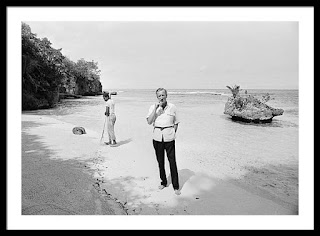Skiing - you head down the slope without thinking about how you will guide your skis around the curves.
Tennis - you head onto the court, not knowing how your racket will meet the ball.
Cooking - you throw a bunch of ingredients in the pan, having no idea what the dish is supposed to be.
I could go on and on, and on, couldn't I? You know me by now. Oh, yes, I can...
Why then, as a teller of tales, would you not at least attempt to visualize the story before you pound the keys or put pen to paper?
This laissez-faire, carefree, attitude about writing a story has always baffled me, and if I'm brutally honest, is why writer's block is a thing for certain scribes.
There's a cure to that writer's block scourge. You want the cure?
It's stop writing and start imagining.
Whoa... heavy, huh? Astrophysicists everywhere are shaking in their pocket protector adorned button down shirts!
Yep, you read me right. Step away from that keyboard. Put down that pen. And conjure up your story world and your characters and the stakes which face them. Mind Craft, peeps. It's the pro writer's best friend.
 |
| Getty Images |
I talk often about how Ian Flemming would lie on the beach in Jamaica and mind map the entire plot of his next James Bond book. Then, he'd amble up to his cottage, pour himself a Vesper Martini and pound the keys like the secretary he was because the story was already sewn in his mind. All he had to do was pound the keys.
I probably cite Flemming's process, a) because I'm jealous of his later life idyllic writer setting in Jamaica, and b) because it just makes sense. (P.S. He deserved all the paradise he could find after his heroic efforts to win the war, just saying...)
Ian knew there was nothing to type until there was a tale to tell.
He didn't need anything but peace and quiet any one of us can find, sans Jamaica, to weave a plot and inject the characters with their strengths, weaknesses, obstacles and stakes on the line. The Bond books were luscious From Here To There adventure tales, with handsome guys, sexy women and evildoers. Just add 1/2 ounce Lillet blanc aperitif, STIRRED, not shaken.
He knew he couldn't leave that beach — half suntanning, half dozing — until the story deed was done and dusted, and he had something to tell.
He visualized to maximize his time in the writer chair. That's simply what he did.
Yes... and then there are pantsers.... *enter horror movie muzak...*
There are two type of pantsers: 1) those who write themselves into vast plot black holes and edit those hopeless drafts until the cows come home; and 2) those who claim they write in the moment but have subconsciously plotted out the tales in their mind, beforehand.
Most pantsers are sadly No. 1
Ian Flemming was No. 2. And so should you be.
You don't need to be a disciplined plotter, but you do need to be a disciplined visualizer.
You need to experience the scenes with all your senses.
You should emotionally feel those scenes. If you don't emote — laugh, cry, rage, arouse — why would your reader?
HOMEWORK: For your next scene in your book, the one which has you stumped, thinking you are covered in Writer's Block bacteria, go somewhere peaceful and let your mind act out that scene. This is not the time to type or write. This is the time to imagine. And don't leave the conjuring until you can "see" the entire scene — its arc — beginning, middle and end.
Writers are conjurers, first. That is how most of us began our story telling, being kids and imagining all sorts... while swinging on swings in a park or picking daisies in a field or people watching at a grown-up party. We conjured the What Ifs that amused us. Why, oh why, should we stop that time-tested story-weaving magic now?
Stop. Drop. And roll your way to an Ian Fleming-like idyllic spot and get to The End in your mind before plunking out the Once Upon a Time on the paper.
It'll work. And if it doesn't, you've found a great place to chill and sip a new martini!













No comments:
Post a Comment